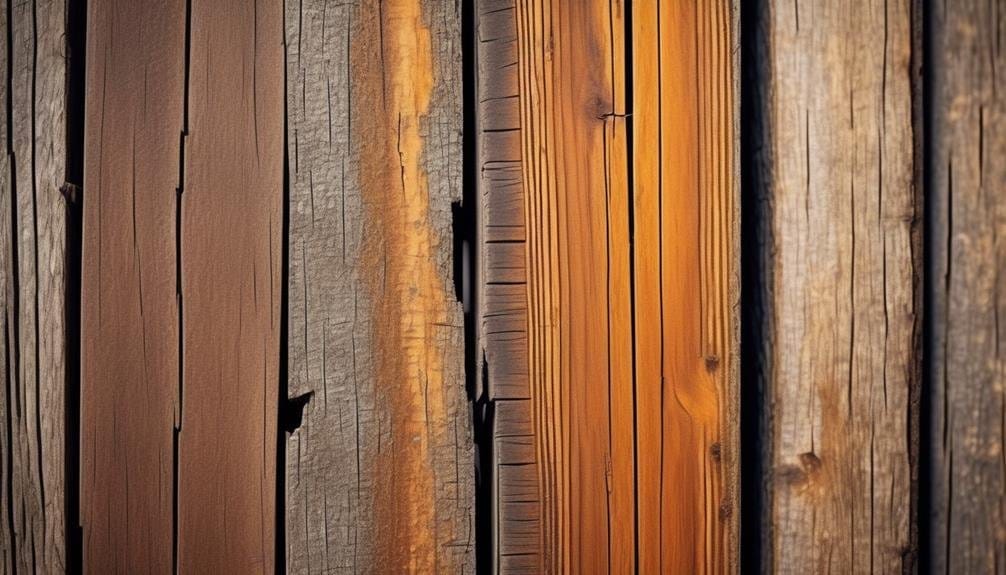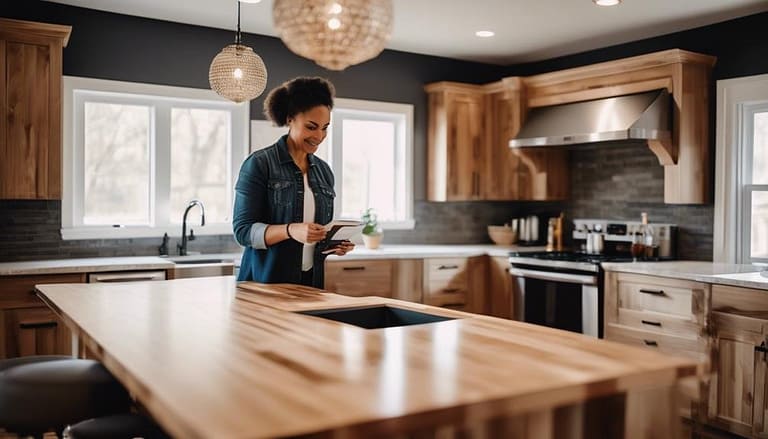Wood Finishing Techniques for Detroit's Weather
When it comes to choosing the right wood finishing technique for Detroit's weather, it may seem challenging due to the city's harsh conditions. However, with the right knowledge and approach, it's entirely achievable.
Understanding the unique challenges presented by Detroit's climate and how they affect wood finishes is crucial to maintaining the beauty and integrity of your wood surfaces. Detroit's weather demands specific considerations when it comes to wood finishing, from extreme temperature changes to high humidity levels.
As we explore wood finishing techniques tailored for Detroit's climate, you'll discover practical solutions that will equip you to protect and enhance your wood surfaces in the Motor City. It's important to address these challenges to ensure the longevity and aesthetics of your wood surfaces in Detroit's climate.
Key Takeaways
Wood finishing in Detroit's weather can be challenging due to the city's harsh conditions. However, with the right knowledge and approach, it's entirely achievable. Understanding the unique challenges posed by Detroit's climate and how they affect wood finishes is crucial to maintaining the beauty and integrity of your wood surfaces. Detroit's weather demands specific considerations when it comes to wood finishing, from extreme temperature changes to high humidity levels.
As we explore wood finishing techniques tailored for Detroit's climate, you'll discover practical solutions that will help you protect and enhance your wood surfaces in the Motor City. It's important to address these challenges to ensure the longevity and aesthetics of your wood surfaces in Detroit's climate. Specifically, considering durable wood finishes and proper sealing techniques can make a substantial difference in preserving wood surfaces in Detroit's weather.
In addition to considering weather-resistant finishes, it's essential to protect outdoor wood surfaces with regular maintenance and inspection. This may include applying a topcoat or sealer to shield the wood from moisture and UV rays. For example, using a marine-grade varnish can provide long-lasting protection against the elements in Detroit's weather.
Transition words: However, Specifically, In addition, For example
Understanding Detroit's Climate
Understanding Detroit's Climate
When finishing wood in Detroit's climate, it's important to consider the continental weather. Detroit experiences cold winters and hot, humid summers, as well as frequent temperature changes and varying humidity levels throughout the year.
In Metro Detroit, knowing the climate is vital for choosing the right wood finishing techniques. The cold winters and snowfall can create difficulties for wood finishing. Low temperatures can slow down the drying process, making it necessary to adjust drying times accordingly.
Conversely, the hot, humid summers can also cause issues for wood finishing. These conditions can lead to uneven drying and potential moisture-related problems in the finished wood. To combat this, using specialized sealants to protect against moisture and selecting finishes that can withstand varying humidity levels may be necessary.
Adapting wood finishing techniques to suit Detroit's climate is essential. By understanding and accommodating the unique climate of Metro Detroit, you can ensure the success of your wood finishing projects and maintain the quality of the finished products despite the weather conditions.
Choosing the Right Wood Finish
Choosing the Right Wood Finish
When finishing wood in Detroit's climate, it's important to choose the right wood finish for your project. Consider the drying method of the finish, whether it's evaporative, reactive, or coalescing, to match the project's needs. Keep in mind that cold air slows down drying, while air movement can help speed it up.
Adjust finishes based on weather conditions, such as thinning finishes in hot weather and choosing quicker-drying finishes for cold weather. These wood finishing techniques are essential for achieving the best results for your woodworking projects in Detroit's ever-changing weather.
Application Techniques for Durability
Tips for Long-Lasting Wood Finishing
To ensure the durability of your wood finishing in Detroit, it's essential to apply the finish evenly and thoroughly, considering the specific weather conditions. Maintaining a consistent temperature of at least 55 degrees, especially in cold weather, will help achieve the best results.
Applying thin coats of finish is crucial for expedited drying, particularly in cold weather conditions. It's important to be aware of how cold weather affects different finishes. Shellac is more tolerant to lower temperatures, while lacquer may require additional heating methods.
When working in cold spaces, such as large areas with high ceilings and concrete floors, taking extra precautions is key for successful finishing. You can also explore additional resources and information for finishing in cold weather, including wood finishing seminars, supplies, and professional advice from experienced wood finishers.
Maintenance Tips for Longevity
Maintaining the longevity of your wood finishes in Detroit requires regular care to withstand the specific weather conditions, including cold temperatures and potential moisture. Proper maintenance is crucial for preserving the beauty and integrity of your wood surfaces. Here are three essential tips to help your wood finishing stand the test of time:
- Regular Cleaning: Dust and debris can build up on wood surfaces, causing premature wear and damage. Regularly dust and clean your wood finishes using a mild cleaner and a soft cloth to keep them looking their best.
- Periodic Inspection: Keep an eye out for any signs of wear, such as scratches, dents, or discoloration. Addressing these issues promptly can prevent further damage and preserve the longevity of your wood finishes.
- Reapplication of Protective Coatings: Over time, protective coatings such as varnish or sealant may wear down. Periodically reapply these coatings to provide an extra layer of protection against Detroit's harsh weather conditions. This will help enhance the durability of your wood finishes and maintain their appeal for years to come.
Special Considerations for Exterior Wood
Finishing exterior wood surfaces requires choosing appropriate finishes that can withstand weather, UV exposure, and temperature changes.
Look for wood finishing techniques specifically formulated for exterior use, as they offer better protection against the elements.
Before applying exterior wood finishes, make sure the wood surface is thoroughly cleaned, sanded, and free from any previous finishes. This preparation is crucial for better adhesion and longevity of the finish.
Also, seal all gaps, cracks, and joints with a durable, weather-resistant sealant to prevent moisture penetration and wood decay.
Regular maintenance is essential, so plan for recoating and regular upkeep of the exterior wood finishes to protect against weathering, fading, and deterioration from sun, rain, and temperature fluctuations.
Additionally, consider natural wood movement and allow for the wood's natural expansion and contraction due to temperature and humidity changes.
Frequently Asked Questions
What Is the Best Wood Finish for Cold Weather?
What wood finish works best in cold weather? Opt for quick-drying options like shellac, lacquer, or spray lacquer in low temperatures. Applying heat can speed up the drying and curing process. It's that simple.
How Do You Finish Wood in the Winter?
During the winter, it's best to finish wood indoors or in a heated space to maintain a temperature above 55 degrees. Thinning finishes can help improve flow and prevent brush marks. Be cautious with water-based finishes as they may dry slowly in cold weather. Using a space heater or working in a heated room can ensure the wood finishing process goes smoothly in the winter. Remember to thin the finishes for better application and consider using oil-based finishes for quicker drying times.
How Cold Is Too Cold for Polyurethane?
In cold weather, polyurethane may not dry properly if the temperature is below 55 degrees Fahrenheit. This can lead to slow drying and curing. In such cases, consider using shellac, wiping varnish, or spray lacquer instead for better results.
How Do You Seal Wood From Humidity?
To protect wood from humidity, you can use a high-quality wood sealant or finish. Make sure the wood is clean and dry before applying the sealant. It's important to regularly maintain the finish to shield the wood from environmental factors and maintain its appearance. For example, using a polyurethane sealant can provide long-lasting protection against moisture. Additionally, applying a water repellent wood preservative like Thompson's WaterSeal can help prevent warping and cracking due to humidity. It's crucial to act promptly to protect the wood from moisture, as prolonged exposure can lead to damage and deterioration. By taking these simple steps, you can ensure that your wood stays in great condition despite humid conditions.






